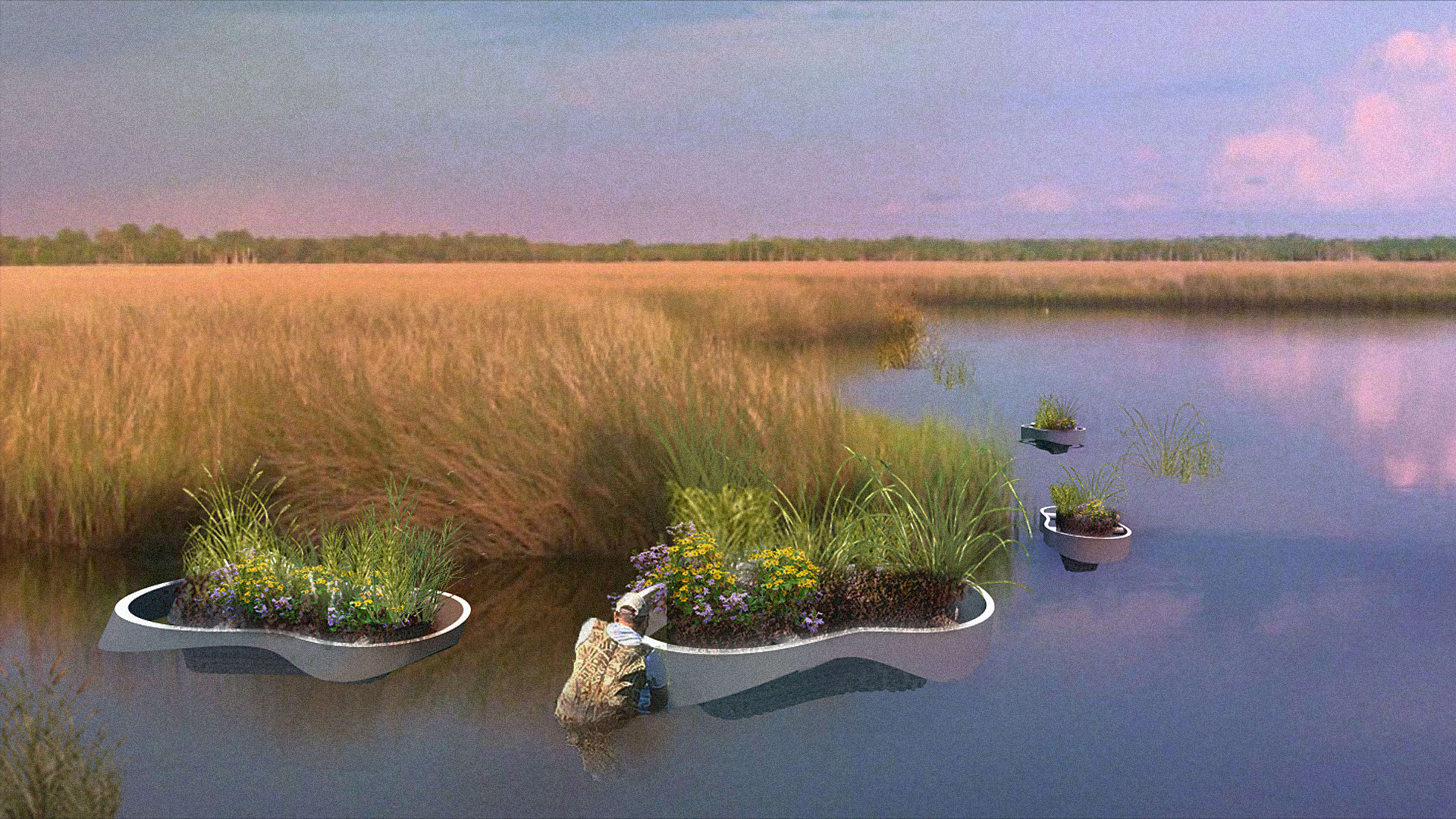The inspiration for TINA, a 3D printed platform that can remove heavy metals from contaminated ecosystems and the winner of this year’s Linda Tischler Award for up-and-coming designers, began with a case of mercury poisoning.
Around the same time that Harvard Graduate School of Design student Mimi Kigawa’s friend fell ill with the ailment, the train derailment and oil spill in East Palestine, Ohio, became national news.

The aftermath of the spill and its harmful impact on East Palestine’s atmosphere, along with the mitigation efforts being explored, caught fellow graduate student Riad El Soufi’s attention. “There was a lot of research about using bacteria to remediate environments, especially in oil spills,” he says. “So we kind of took those two things … and made this into a project.”
For Harvard’s Master in Design Engineering program, El Soufi and Kigawa teamed up with classmate Connie Wang to develop a low-tech design that explored the capabilities of bioremediation, an organic process through which living matter like bacteria naturally removes and breaks down toxins in an ecosystem. Mining, pesticide runoff, and factory pollution have led to the contamination of about 40% of lakes and rivers globally, a statistic that has been further exacerbated by climate change.

The team’s efforts resulted in TINA, which provides a platform for a bacteria called Pseudomonas Putida MnB1 (or P. Putida, for short) to grow in lab conditions that mimicked an estuary, thanks to real water samples being taken from nearby Rumney Marsh and Revere Beach in Revere, Mass. The bacteria, which El Soufi took to affectionately calling TINA—inspiring the project’s name—is capable of pulling manganese from an ecosystem and separating the metal through a filter, which can then be extracted and repurposed into lithium-ion batteries.
Shaped like a floating island, native, non-intrusive plants rest atop TINA. Some of the vegetation not only engages in a separate bioremediation process, but actually lives in symbiosis with P. Putida. One paper found that the bacteria actually strengthened a rice plant known as Oryza Sativa by protecting it from common infections. The P. Putida is housed inside the actual structure, where it grows on a curtain of 3D-printed Triply Periodic Minimal Surfaces (TPMS). The name sounds complex, but these structures essentially maximize the surface area of a given space, which allows bacteria like P. Putida to flourish and produce a biofilm.

“We learned that bacteria likes growing in really flat surface areas, as opposed to edges or corners,” Wang said, explaining that these structures were crucial to increasing P. Putida growth during the short time period she and her team had to experiment.
The biofilm created by P. Putida then pulls manganese from its environment, which is removed through suction piping once the biofilm reached a maximum state to support bacterial growth. To keep other marine life from consuming the algal buildup caused by the bacteria—and in turn, harmful and high concentrations of metals—a mesh netting surrounds the TPMS curtain.
The team behind TINA emphasized that the device simply facilitates an already occurring process.

“For us, it was thinking not only about what’s going to go into the design of what we’re creating … it’s kicking off a process of thinking about how [we can] use these natural systems that do exist, and harnessing them in a way to kind of work towards something regenerative,” Kigawa said.
It’s important to note that El Soufi, Kigawa, and Wang are not scientists. Collaborating with environmental lab staff at Harvard, the students condensed typical scientific methods to fit a tight time constraint, so that TINA was tested under a “more product and tech mentality … [where] being roughly right is better than being totally wrong,” according to Wang.
The team wanted tangible results to present at the end of their project period, during which they only had 12 weeks to gauge TINA’s efficacy. While they admitted that parts of the process—particularly the actual extraction process of metals from an ecosystem—would benefit from more testing, they emphasized TINA benefitted from being treated as a design project rather than a science experiment.
“We’re not saying, ‘oh, you don’t need to do the scientific process,’ there’s obviously value in that,” Wang said. “But I think in specific types of design or engineering type projects, there’s a lot of value in being a little more flexible.”
Additionally, while TINA has only been tested in a lab environment using a specific strain of bacteria to remove a specific type of metal from a specific ecosystem, the platform itself is designed to work when any—or all—of these variables are adjusted.
Wang explained that across bacteria, algae, and fungi, there are 70 known species that are capable of degrading heavy metals. “I think there’s definitely a lot more room for experimentation in terms of which bacterial strains and what types of metals might be the right sort of ones to actually use in a platform like this,” she says.
TINA received the highest distinction at Harvard’s Master in Design Engineering program, and has since been presented at two conferences. Moving forward, the team hopes that TINA demonstrates the importance of the intersection between science and design.
“I think the limelight that it’s getting, and will get, hopefully inspires other people to look at bio-based solutions and nature-based solutions,” Wang says. “I think that’s a really, really, really big deal when it comes to working in climate.”
El Soufi wants mining companies to consider bioremediation efforts when it comes to company community service initiatives or Corporate Social Responsibility. “These big polluters can start thinking about projects such as these that go a little bit beyond the norm of ‘let’s just plant trees where we’ve been polluting for 20 years,’” he says.
Recognize your brand’s excellence by applying to this year’s Brands That Matter Awards before the final deadline, June 7.
Sign up for Brands That Matter notifications here.
